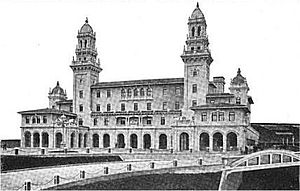Terminal Station (Atlanta)
|
Terminal Station
|
|
|---|---|
| Inter-city rail | |

Terminal Station in 1918.
|
|
| Location | 75 Spring Street SW Atlanta, Georgia, United States |
| Coordinates | 33°45′11″N 84°23′46″W / 33.753°N 84.396°WCoordinates: 33°45′11″N 84°23′46″W / 33.753°N 84.396°W |
| Line(s) |
SOU SAL CG AWP |
| History | |
| Opened | May 1905 |
| Closed | June 1970 (demolished 1972) |
| Rebuilt | 1947 |
Terminal Station in Atlanta was the larger of two principal train stations in downtown, Union Station being the other. Opening in 1905, Terminal Station served Southern Railway, Seaboard Air Line, Central of Georgia (including the Nancy Hanks to Savannah), and the Atlanta and West Point. The architect was P. Thornton Marye, whose firm also designed the Fox Theater and Capital City Club in downtown Atlanta, as well as the Birmingham Terminal Station.
At the station's opening in 1905 the military band of the 16th Infantry Regiment played "Down in Dixie" according to a report that appeared in the Atlanta Journal.
In its 20th century heyday, Atlanta Terminal Station was used by such well-known trains of the time as the Crescent, Man 'o War, Nancy Hanks, Ponce de Leon, and Silver Comet. A veritable rail-travel crossroads of the American south-east, it was a critical railroad link between the warm climate of Florida and the Gulf Coast, and the rather colder, more densely populated states of the north-east and mid-west. For many northern Americans, Atlanta Terminal was the gateway to the sunshine. The Atlanta Convention Bureau released a postcard in the 1920s that claimed that Terminal Station was served by 86 trains per day.
...
Wikipedia
